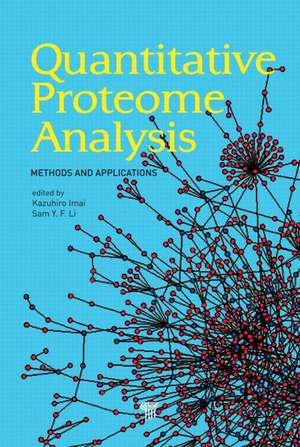Quantitative Proteome Analysis: Methods and Applications
Editat de Kazuhiro Imai, Sam Li Fong Yauen Limba Engleză Hardback – 5 aug 2013
Preț: 877.59 lei
Preț vechi: 1179.32 lei
-26% Nou
Puncte Express: 1316
Preț estimativ în valută:
167.94€ • 174.27$ • 140.37£
167.94€ • 174.27$ • 140.37£
Comandă specială
Livrare economică 22 februarie-08 martie
Doresc să fiu notificat când acest titlu va fi disponibil:
Se trimite...
Preluare comenzi: 021 569.72.76
Specificații
ISBN-13: 9789814316514
ISBN-10: 9814316512
Pagini: 312
Ilustrații: 21 b/w images and 4 color images
Dimensiuni: 152 x 229 x 23 mm
Greutate: 0.57 kg
Ediția:1
Editura: Jenny Stanford Publishing
Colecția Jenny Stanford Publishing
ISBN-10: 9814316512
Pagini: 312
Ilustrații: 21 b/w images and 4 color images
Dimensiuni: 152 x 229 x 23 mm
Greutate: 0.57 kg
Ediția:1
Editura: Jenny Stanford Publishing
Colecția Jenny Stanford Publishing
Public țintă
Academic and PostgraduateCuprins
FD-LC-MS/MS. 2-D DIGE. Mass Spectrometry Utilizing ICAT. Proteomic Analyses of Post-translational Modifications. Cardiovascular Proteomic Analysis. Proteome in Neurodegenerative Diseases. Liver Disease-Related Proteome. Respiratory Disease Related Proteome. Renal Disease-Related Proteome. Aging-Related Proteome. Phosphoproteomics of Tumor Cell Lines. HCV Infection and Mitochondria Proteomics. Infectious Disease by SELDI. Quantitative Proteomic Analysis of HIV Infection.
Descriere
This book focuses on the advantages and disadvantages of each of the commonly used quantitative proteomic methods in terms of accuracy, sensitivity, and reproducibility. It also concentrates on the effective applications of these methods that resulted in many discoveries of the role of the proteins expressed in living cells and biological fluids. The first part of the book focuses on the description of advantages and disadvantages of each of the commonly used quantitative proteomic methods in terms of accuracy, sensitivity, and, especially, reproducibility. The second part of the book focuses on providing concise descriptions of the effective applications of these methods to demonstrate how they have resulted in many important discoveries of the roles of the proteins expressed in living cells.
